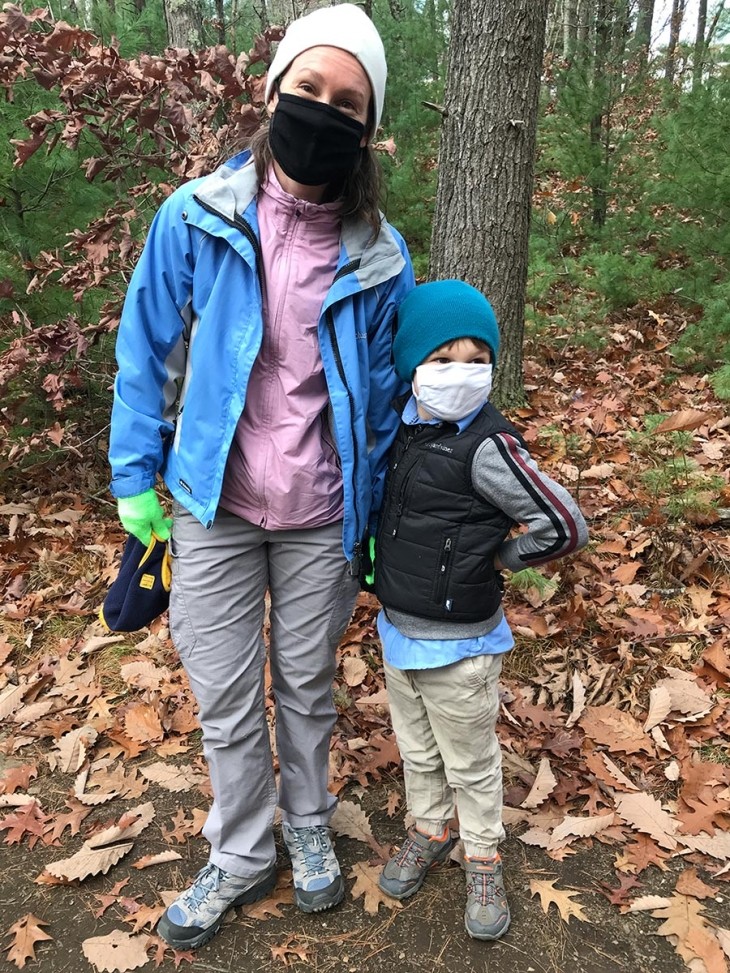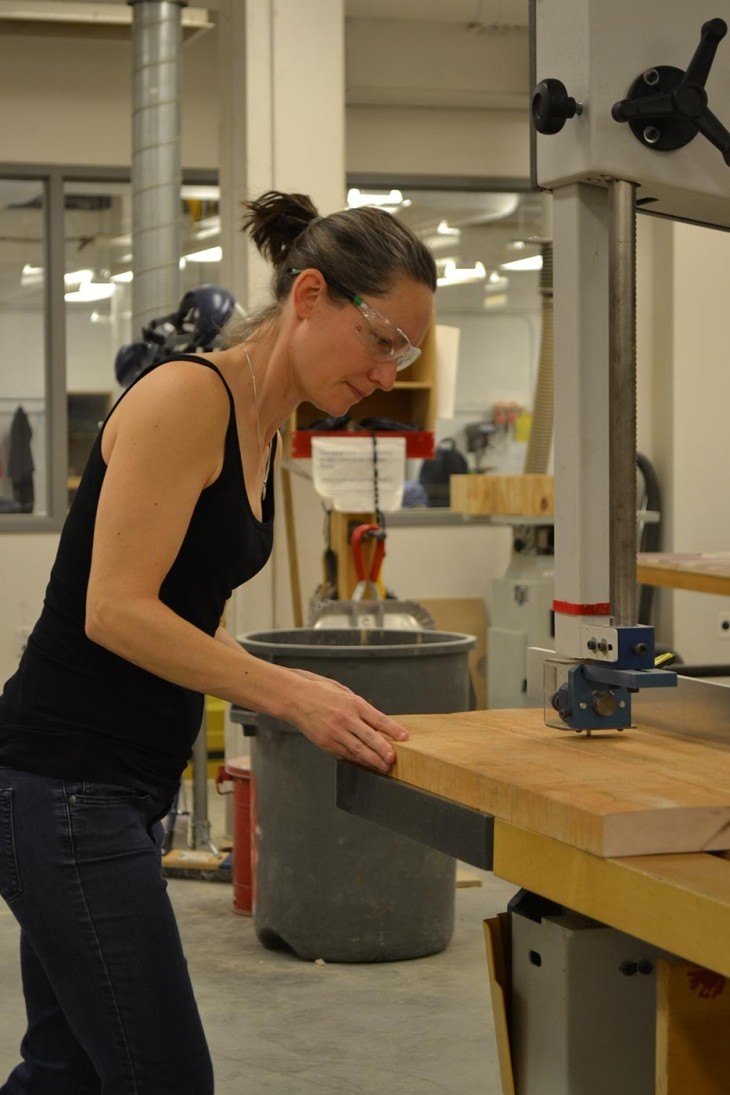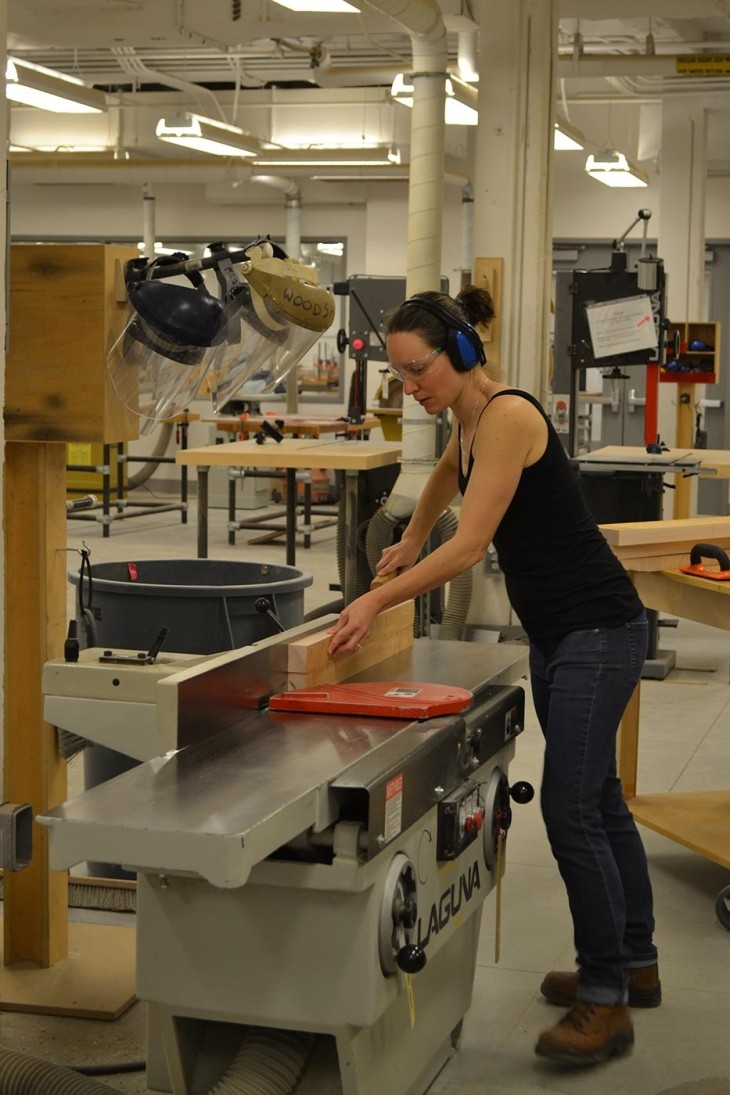
A resident of Boston’s South End, Carolyn Lowell is a former high school math teacher now working toward a master’s degree in architecture from the Massachusetts College of Art and Design. She’s also a mother of two sons (ages 4 and 7), a hiker and bicyclist, and has a budding interest in woodworking – inspired, in part, by her participation in a project we featured in the Spring 2020 issue of Northern Woodlands magazine. This project is also the focus of a free January 20th webinar co-sponsored by Northern Woodlands, the New England Forestry Foundation and the Massachusetts Woodlands Institute (a subsidiary of the Franklin Land Trust). Information about that event and related webinars in the series “Local Wood: Grow, Build, Live” is available here.
The house where I grew up in Concord, Massachusetts, is situated on a wooded lot with significant grade changes. As kids, my brother and I made our own trails through the woods. We’d drag tree limbs around so we could have better pathways and mound pine needles and sticks to make “walls” for our play forts. We were lucky to have so much freedom to explore right out our backdoor. Down the street from our house was a swampy area, part of the old rifle range in Concord, where we’d meet other kids from the neighborhood. Even in colder months my friends and I would take thermoses of herbal tea outside to pretend we were pioneers, à la Laura Ingalls Wilder. My best memories from childhood are all of being outside, in the woods.
I’m sure my time spent outside as a child influences my design work. I take great inspiration from nature. My most recent studio project used the concept of a fern as a framework to design supportive housing. I used the fern’s fractal, self-similar form, its gentle sweeping curves, and its color palette to move my design forward. When I approach a design problem, I always keep in mind the relationship between the built environment and its surroundings and prioritize outside spaces as much as inside spaces. I prefer to use natural materials and textures in my designs, partially because they are beautiful but also because they can be more sustainable when sourced properly.
My shift to pursuing a degree in architecture was a multistep process, and everything sort of happened at once. The year after our first son was born and I was still teaching was very hard, and I decided to transition from full time teacher to full time mom for a while. We had just completed a renovation of our condo and had bought the house across the street, which also needed major renovations. I was very involved in the renovation process of this house, where we live now, and I just loved it. I loved all of the decisions that we had to make, the design process that we went through. And I also loved the actual construction. I helped with various construction-related tasks along the way. And at the end of that, I decided I wanted to go back to work as an architect rather than as a teacher. After taking continuing ed classes and completing an internship with the architect who worked with us on our house, I applied to the master’s degree program at Mass Art.
I loved working in the woodshop during my continuing ed coursework, so I signed up to take sustainable furniture design with Mitch Ryerson at Mass Art as a professional elective. It was one of my favorite courses that I’ve taken at Mass Art. It was a group project that we did. We designed the conference room tables for the New England Forestry Foundation (NEFF), a total of eight tables using sustainably and locally sourced hardwood. With any well-run group project, you get a really nice sense of camaraderie and shared purpose. It was a fun project with a diverse group of students. There were industrial designers, architecture students, just a really interesting mix.
As part of the project, we visited the NEFF headquarters in Littleton, Massachusetts, and took a tour of their forest and talked about sustainable forestry practices and the ways people can harvest in an ecologically sensitive way. Designers and architects really have a responsibility to think about how to make our products more sustainable, partially because they have such a long lifespan. Buildings have a longer lifespan than almost any other product. And they use something like a third of all energy used in the U.S. So anything you can do to make your project use less energy, be more sustainable, have lower lifecycle energy costs is really important. We can design in ways that do not contribute to the global issues of climate change, and contribute to a culture that places value on the lifecycle of the things we produce. In learning about sustainable forestry practices and sustainable design, I’ve come to a deeper understanding of how interconnected all our activities are.
I really like making things. Making furniture isn’t dissimilar to making buildings. You need to understand scale, texture, and form. You need to consider forces, how materials and connections work under different kinds of stress, and how to put things together. I think I am more attuned now to the number of species that are in the forest. When you’re actually working with the different types of wood and seeing their physical properties, it just gives you a different appreciation for the different ways that they’re beautiful.
We used curly maple in part of our project for NEFF. It was such a revelation to me to see that pattern. It has– I think they call it chatoyance – sort of this reflective quality, so it looks really different depending on what angle you look at it. It’s just gorgeous. We’ve all seen maple trees, we’ve eaten maple syrup, we’ve seen maple tables. I don’t think I’d ever seen curly maple before and known what it was.
I still spend a lot of time outdoors. My parents are in Concord still, so we go out there pretty much every weekend for at least one day. The kids get to just roam around and be kids in areas that they can do whatever they want. And my family and I hike almost every non-school day. Our favorite local places are the Blue Hills, Middlesex Fells, and Breakheart Reservation. We were already hiking prior to the pandemic. Now it’s much more important, because there aren’t a lot of other options.
One of the small side benefits of the pandemic is that fewer people think you’re crazy for suggesting we all spend time outdoors, even when it’s cold. It always feels odd to talk about the benefits of the pandemic, because obviously no one would choose this, and it’s been horrible for so many people in so many ways. But there are very small things, like everyone being more comfortable spending time outside. We see a lot more people on the trails now. Hopefully people will keep that spirit of being outside, even after we’re allowed to go places and be inside together.




